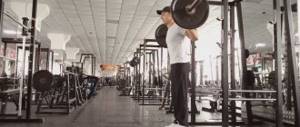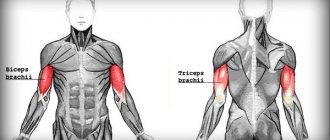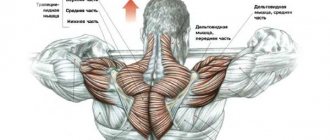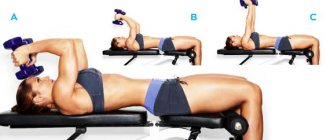Working out the trapezius muscle is very important both for appearance and for developing strength and protecting joints from injury. Basic back training does not load the trapezius enough; additional isolated exercises are required to pump it up. Let's look at how to pump up the trapezius, basic exercises and training principles that allow you to achieve a rapid increase in the volume and strength of this muscle.
A well-developed trapeze gives a powerful look and completeness to the upper torso. But this only applies to the male figure. A pumped-up trapezius does not decorate girls and women; they may need to pump up the trapezius muscle only in preparation for serious bodybuilding competitions.
A little anatomy
The trapezius muscles, or simply trapezius, can be seen in the very upper part of the back. They border on the muscles of the shoulders, neck, and latissimus dorsi. Their shape is similar to a diamond.
If the trapezius is well developed, they ensure normal functioning of the neck and shoulder girdle, and prevent injuries to the cervical vertebrae and collarbones under high loads.
The trapezius is divided into three areas, each of which needs to be worked on separately. This is the upper area, middle and lower.
Train your traps 2 times a week
Even the most stubborn part of the body cannot resist increased attention. If the trapezes don't live up to your hopes and expectations, start working on them twice a week. For your first workout, put them at the beginning of the session (say, back day), and then come back to them a couple of days later, but train them at the end of the session (maybe chest day or shoulder day).
Load your traps like this and they will have no choice but to adapt. But if your muscles continue to hurt, or if they stop responding to this format, return to one workout per week. By the time this happens, you should already be seeing major improvements in the trapezius muscle area.
How does a trapezoid work?
The upper one raises the scapula and participates in lifting the entire shoulder girdle. It works especially well with shrugs. You can use different techniques for this exercise.
The middle one is involved in bringing the shoulder blades to the spine. It is worked through exercises such as bent-over rows, wide-grip pull-ups, and exercises on cable machines.
The lower one takes part in lowering the shoulder girdle and scapula. It can be worked out with the help of presses.
There are several trapezius exercises with dumbbells. These are shrugs, pull-ups, bent-over rows and others. Not all of them are equally effective. The most useful of them are shrugs, which are aimed specifically at working the trapezius. In other exercises, this group of muscles is additionally included.
Functions of the trapezius muscle
The main practical function of the trapezius muscles is to hold weight on straight arms . When you go with full bags of goodies from a supermarket or market, be sure that your trapezes are working at this time. However, this is not the only function of such a considerable muscle. Raising the shoulder blades relative to the spinal column, as well as bringing the shoulder blades to the spine, are also trapezoids. In other words, when you shrug your shoulders to let your interlocutor know that you don’t know the answer to his question, your trapezius is back in action.
Shrugs with dumbbells
This popular exercise, the shoulder shrug, is designed to work the trapezius. Its upper part is trained as much as possible with a slight grip on the middle. In terms of difficulty level it is classified as simple. In addition to the trapezius, the rhomboid muscles are also involved. How to pump up the trapezium with dumbbells using shrugs?
Men are recommended to do 10-15 repetitions in three sets with dumbbells weighing 10-15 kg. Women need to do 10-15 repetitions in three sets, with dumbbells weighing 5-8 kg.
The advantages of pumping trapezius with dumbbells using shrugs over a similar exercise with a barbell are that the dumbbells are not in front (behind), but on the sides, so they are more convenient to hold, the range of movements is greater, you can vary the technique to better work out the target muscles. For example, with dumbbells you can not only lift your shoulders up, but also pull them back and rotate them.
It can be performed in several variations, but the main principle is the maximum lift of the shoulders up.
Before you start doing trapeze shrugs with dumbbells, you need to warm up.
Then place your feet shoulder-width apart, pick up dumbbells and hold them in your arms along your torso. Do not bend your elbows and do not strain your biceps brachii muscles.
Stand with your back straight, chest protruding forward, shoulders slightly back. Tuck your stomach in and look forward.
Raise your shoulders as high as possible. In the upper phase of the movement, with maximum contraction of the trapezius, take a short pause - 1-2 seconds.
Slowly move your shoulders down, trying to lower them as low as possible so that the muscles stretch better.
The weight must be selected in such a way that you can perform 10-15 repetitions in three sets without compromising your technique.
This was a classic dumbbell shrug.
You can use two more types of exercise in your training.
The first is to lift your shoulders not straight up, but first forward, then up.
The second is bent over shrugs. The body is tilted forward, the back is straight, the legs are slightly bent at the knees. Perform shoulder raises from this position.
Bodyweight exercises
Workout enthusiasts can pump up their trapezius using their own body weight. Let's look at how to do this on the horizontal bar, on uneven bars, and also in the absence of these apparatuses.
Horizontal bar
To pump up your trapezoid on the horizontal bar, you need to be able to do pull-ups. Upside down pull-ups are especially effective for training the trapezius muscle. They are performed like this:
- Assume a hanging position on the bar.
- Give your body a horizontal position by raising your bent legs up.
- Do pull-ups in this position, while squeezing your shoulder blades and straining your back.
If you can’t do pull-ups on the horizontal bar upside down yet, you can do them on the uneven bars. This can be easily done by hanging and at the same time placing your feet on the bars so that your body is parallel to the floor. The main thing is not to forget to squeeze your shoulder blades together and tense your trapezius muscle when doing pull-ups.
Bars
You can pump up your trapezoid with a simple exercise on the uneven bars. To do this you need:
- on the uneven bars, go point-blank with straight arms;
- from this position, stretch your neck up with all your might, while straining your back muscles, bringing your shoulder blades together, sticking out your chest and arching your lower back;
- Having fixed in this position for a couple of seconds, relax your shoulders and “immerse” your neck in them;
- repeat stretching the neck with tension in the back muscles and subsequent relaxation until muscle failure occurs.
Do not forget that throughout the entire exercise you need to maintain the position of emphasis on straight arms.
Handstand
You can pump up the trapezoid without any equipment, and the effect of the exercise will be no worse than when using dumbbells and barbells. With this exercise you can pump up your trapezius at home. True, it’s not easy to do:
- do a straight arm stand with your feet leaning against the wall;
- stretch your whole body upward, straining your trapezius and squeezing your shoulder blades together;
- Having fixed yourself in the extreme position for a couple of seconds, relax your shoulders and lower your body down vertically without leaving the stance;
- repeat the exercise until the muscles are completely tired.
Having set yourself the goal of pumping up the trapezius, do not forget that attention must be paid to working out all muscle groups. Only under this condition can you get a harmoniously developed and strong body.
Two-arm dumbbell row
This is another dumbbell trapezoid exercise. During execution, many muscles are involved in the work. The main group for which it is intended is the latissimus dorsi, but with a certain technique the middle part of the trapezius will also be involved: if you bring your shoulder blades together as much as possible.
Technique:
- Stand with your feet shoulder-width apart and hold dumbbells in your hands. Bend the body until a right angle is formed at the hip joint. That is, the more horizontal the body is located, the better.
- The back should be straight, and it is imperative to maintain a natural curve in the lower back. If you feel discomfort, you need to straighten up a little to make it comfortable.
- The dumbbells are held in outstretched arms. As you exhale, pull the dumbbells up by bringing your shoulder blades together.
- At the highest point of the movement, squeeze your shoulder blades together as much as possible and hold for one to two seconds.
- As you inhale, lower the dumbbells and return to the starting position.
It is recommended to do 12 repetitions in three sets. Weight is selected individually. Approximately, men need to take dumbbells weighing 8-12 kg, women - 4-7 kg.
Dumbbell Pull
Consider this dumbbell trapezius exercise. It is designed to work the front deltoid, but the work also includes the trapezius, namely their lower part. Difficulty: medium.
To perform a pull-up, you need to stand straight with your feet shoulder-width apart, holding dumbbells in front of you, palms facing your hips.
Bend your elbows and pull the dumbbells up along your body in a straight path, using the deltoid and trapezius muscles. The movement occurs vertically and as close to the body as possible. The elbows rise to the sides and are always located above the hands, the forearms hang down slightly.
Bring the dumbbells to your chin, trying to raise your elbows as high as possible. When lifting dumbbells to the shoulders, the main load goes to the deltoids; after passing this line, it moves to the trapezius muscles.
After reaching the highest point, the dumbbells should be held for one or two seconds and gradually lowered.
The main advantage of rowing with dumbbells, compared to a barbell, is that they put less stress on the joints.
Men are recommended to do 10-15 repetitions in three sets with dumbbells weighing 7-10 kg. Women – 10-15 repetitions in three sets, with a weight of 3-5 kg.
Trapezius workout with back
The argument for training the trapezius together with the back muscles is the fact that the trapezius muscles themselves are large back muscles involved in supporting the spine.
The trapezius is involved in basic back exercises such as hex bar deadlifts, rack rows, and bent-over barbell rows.
Since the traps work during these basic exercises, it makes sense to train them together with the back.
Back workout sample
| Exercises | Approaches | Repetitions |
| 1. Deadlift | 5 | 5 |
| 2. Bent-over barbell row | 3 | 10–12 |
| 3. One-arm dumbbell row to the waist | 3 | 10–12 |
| 4. Block pulldown with a narrow grip | 3 | 10–12 |
| 5. Lower block row with straight arms | 3 | 10–12 |
| 6. Shrugs with a barbell | 3 | 15 |
Bent over dumbbell swings
This dumbbell trapezius exercise can be used to target the lower portion of this muscle group. It is aimed primarily at developing the rear deltas, but the work also includes trapezoidal, as well as diamond-shaped, middle deltas and others. Difficulty level is high.
It is recommended to do 10-15 repetitions in three approaches. The weight of dumbbells for men is 5 kg (each dumbbell), for women – 3 kg.
It is recommended to perform with prepared abdominal and back muscles, since there is no support.
Technique:
- Feet shoulder-width apart, body tilted to a parallel half-position, knees slightly bent.
- The back should be straight. Rounding the back is not allowed, as this can lead to injuries in the lumbar region.
- Dumbbells are in freely lowered hands. Bend your elbows slightly and turn to the sides.
- Exhale and swing the dumbbells out to the sides. Hands are raised to shoulder level, elbows pointing toward the ceiling. You cannot help by rocking your back or jerking. In the upper phase of the movement you need to swing at a faster pace.
- Inhale, smoothly lower your hands into and. n. In the lower phase the movement is slower.
While working on weight, do 8-10 repetitions in four approaches.
Seated dumbbell flyes
This is a variation of the standing bent over swing. And the target muscles here are the rear deltoids, but the trapezius is also included in the work.
Technique:
- Sit on the edge of the bench. Lie with your stomach on your thighs, lightly weighted dumbbells hanging freely in your hands. Bend your elbows slightly and spread them apart.
- Exhale and perform dumbbell raises through the sides without lifting the body. The position of the body cannot be changed.
- Inhale and slowly return to the starting position. Lowering the dumbbells is slower than swinging up.
It is recommended to perform the exercise 8-12 times in three to four sets with 1 minute rest between sets.
The lower trapezius is also engaged when lifting dumbbells overhead. Such presses are usually performed to train the shoulders.











